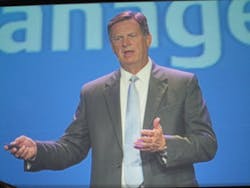One of the clearest trends for large automation suppliers over the past few years has been their increasing focus on services. Where such suppliers once primarily focused on product development and sales, with implementation services being an add-on offering, these same suppliers are increasingly finding that being specified as the main automation contractor (MAC) on a project is a critical factor in their ability to sell products and services.
This trend has largely been driven by the decrease in engineering resources at production facilities, which, in turn, has increased the need for hands-on engineering experience supplied by outside sources.
“We've grown faster than the industry as a whole,” said Steven Sonnenberg, president of Emerson Process Management, “and that’s been due to a mix of reasons. One of those reasons is through winning a number of big projects as a MAC.”
Sonnenberg noted that Emerson has grown by about $1 billion a year over the past couple of years, reaching $7.9 billion in sales in 2012.
In a session moderated by Lance Boudreaux, business leader for Daniel Measurement & Control, at Emerson Process Management’s 2013 Global User Exchange, the topic of MACs and their role in system and device selection and implementation was discussed. In particular, the forum focused on end users’ expectation of the MACs and EPCs (engineering, procurement and construction) firms they work with on large projects. Sitting on the panel were representatives from Shell, ExxonMobil, and Wood House Group Mustang (an energy services provider).
“Emerson executes MAC contracts based on client requests,” said Vince Grindlay, manager of BP contracts for Emerson Process Management, during the session. “Because MAC contracts are very complex, we start project meetings now by first focusing on role alignments.” He added that, operating as a MAC, Emerson works directly with EPCs in these meetings to provide consistency across the project.
Mark House of Wood Group Mustang concurred saying, “We stopped doing general kickoff meetings awhile back and now focus initially on MAC and EPC alignment meetings to define project scope, rules, and responsibilities.”
Underscoring the importance having the MAC and EPC on the same page from the start, Sandy Vasser, facilities electrical and instrumentation manager at ExxonMobil Development, said that ExxonMobil creates a Project Automation Collaboration and Engineering (PACE) team that all players are a part of so that no one “sees themselves as separate companies while working on the project.”
Getting down into the details of big automation projects, session panelists and audience members concurred that ballooning I/O counts can be one of the biggest factors in affecting total project costs. One audience member noted that I/O counts can easily double or triple during the course of a project.
“Predicting what the actual I/O count is going to be is the real challenge,” said Vasser. He pointed to project rework and redesign once the project has started—as directed by the client—as being one of the biggest problems with total project cost and scheduling.
Another audience member noted that they work with MACs principally because they want a fully integrated system, yet their experience has shown that they still tend to end up with automation products from many different providers that aren't always easy to integrate. As a result, end users are often left to wonder how to most effectively handle asset management.
All of the panelists agreed that it is ultimately the MACs role to ensure integration of the disparate products that will inevitably be used to develop a system based on MAC and EPC recommendations.
“This (automation project system integration) requires a lot of oversight by the MAC of the EPCs,” said House. “We bring in EPC instrument leaders and conduct budget reviews, but we consider the MAC to be responsible for asset management systems and overall integration with end devices.”
Vasser added that ExxonMobil does not see the MAC as being a general contractor for everything on a project. “We look to them as being responsible for the core automation systems, not end devices—even if they’re the ones that provide them. We see EPCs as being better at overseeing end devices.”
Leaders relevant to this article:


